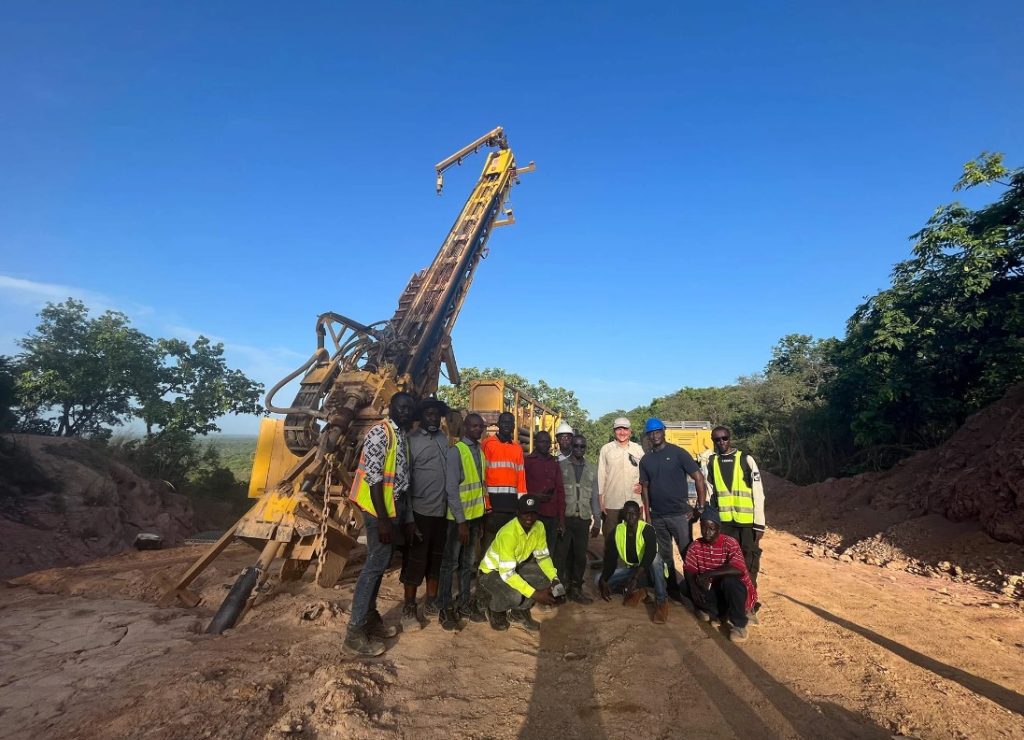Sanu Gold drilling Bantabaye Project, Guinea, West Africa

Sanu Gold Corp. [CSE-SANU; OTCQB-SNGCF] reported that drilling has begun at the company’s flagship Bantabaye Project, located on the prolific western margin of the Siguiri Basin of Guinea, West Africa. A reverse circulation (RC) rig is currently operational with a fully funded initial 3,500 metres of drilling underway with 35 holes planned.
Highlights – Drilling has Commenced: Three holes have been completed at Target 2 in the vicinity of hole BANT-RC-002 which intersected 11.5 g/t gold over 15 metres.
Extensive Drilling Planned: The company has planned an initial 3,500 metres of RC drilling in approximately 35 holes to both define footprints of gold mineralization and to test at depth of Target 2.
Initial Focus on Target 2: The first 35 holes are planned to both immediately and aggressively step-out from BANT-RC-002 across an initial strike length of 500m and down dip-extent of 150 metres thus outlining potential for mineral resources. Drill pads for more aggressive 100m step outs along the 1,100-metre strike length of the target are being planned.
Additional Drilling Planned: The company is fully funded for an additional 4,500 metres of RC drilling at Bantabaye where there are extensive gold zones present at surface requiring follow up and specific targets and drill plans are currently being finalized. Additional priority targets under evaluation for drill testing are Targets 1, 3, 7 and 8.
Martin Pawlitschek, President, and CEO of Sanu Gold commented: “We are thrilled to be back at Bantabaye following up on last year’s outstanding drill results from the discovery at Target 2. The initial Phase of drilling will aim to confirm the gold mineralized structure defined by mapping and geophysics along a 500m strike length centered on last year’s holes, with a program of systematic RC drilling testing the shallower portions of the zone up to 150m down dip. After this initial phase at Target 2, the rig will complete further drill testing on selected other key Targets. The recent PDIP geophysics is currently being integrated into the final hole planning and prioritization at Targets 1, 3 and 7.”
The Phase 1 drilling program at Target 2 consists of 35 planned holes for an estimated total of 3500m. Final hole length will be determined by the geology encountered down hole. The initial nine holes will consist of close step outs and infill on last year’s drill lines. Previous drilling at Target 2 was limited to two NNE (030) oriented drill lines with three holes each, testing the mineralization to a vertical depth of only 75 metres.
The remainder of the holes are planned on a 50 by 50m grid stepping out along both strike directions from last year’s intercepts and covering a total of 500m of strike length and testing the upper 150m of the structure. Phase 1 has been prioritized to test this 500m zone, which is traceable in exposure created by artisanal activity, well developed surface gold anomaly and has a coincident expression in the recently completed geophysics. The down hole logging of each RC hole will serve to confirm or refine the current model and if warranted modify or re-prioritize the phase 1 drill holes.
Beyond this 500m zone the structure is covered by a thick laterite plateau, where it can be traced by the gradient array IP geophysics and in some places coincident surface gold geochemistry. Additional step out drilling over the remainder of the 1100m strike length at Target 2 is being considered. Deeper testing of Target 2 will likely require the use of a diamond drill rig.
The company has integrated the recent geophysics, 2023 drilling and surface data into the structural model shown in Figure 2. Similar work is in progress for the other targets and will be announced as soon as practicable.
The Phase 1 drilling program will be completed but may be adjusted on the basis of observed geology and early assay results.
The company and its contractors and consultants continue to process and update its geological models, plan target testing on the other targets and continue with drill pad access preparations.
The company is being advised on the IP survey by in3D Geoscience, an independent geophysical consulting firm based in British Columbia.
The company has defined multi-km scale gold-bearing structures on each of the gold exploration permits, with multiple high-value drill targets.
